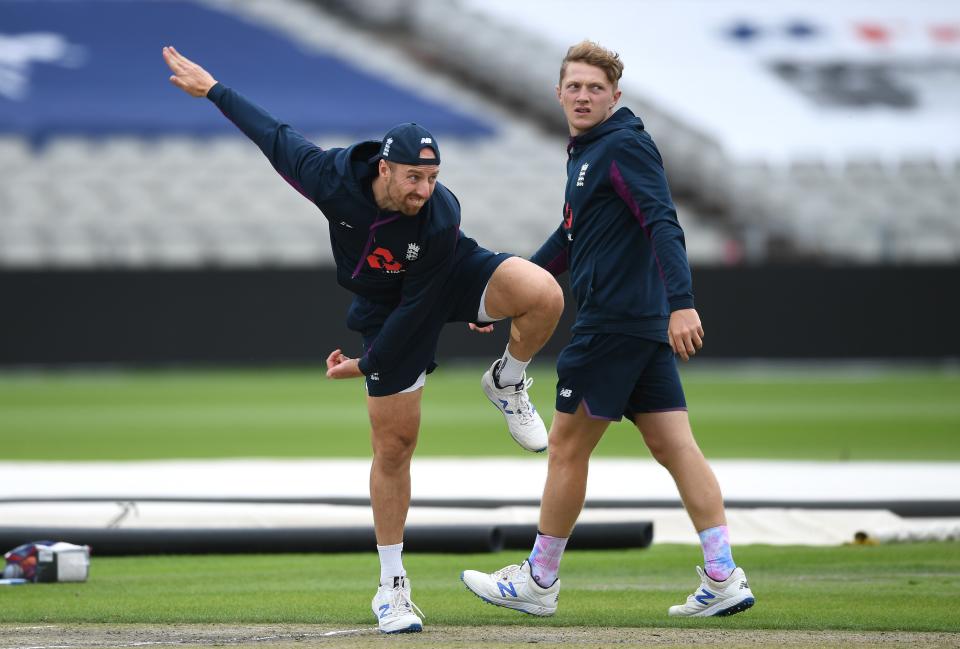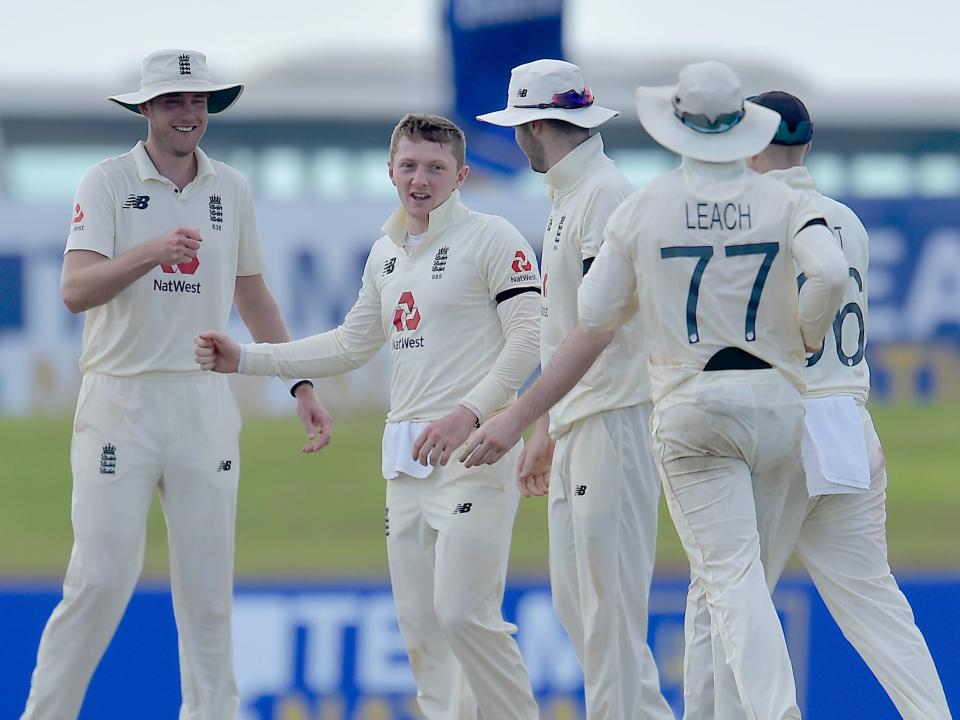‘The hardest craft’: The perception and curse of being an England spinner

Jack Leach and Dom Bess were England’s two lead spinners in Sri Lanka
(Getty Images)"But... I just feel like if a seamer bowls a wide half volley and they get nicked… Do you know what I mean?"
Dom Bess is tired, and a touch exasperated, after being asked to assess his own fortune at the end of 2021’s first day of Test cricket. England had bowled Sri Lanka out for 135 thanks to his five for 30, figures that will likely remain his career-best for some time. By his own admission, he did not bowl well for them.
Having indulged his humility for one answer too many, he had a bone to pick. Specifically, on one dismissal – a drag down slapped straight to a fielder by Niroshan Dickwella.
"I've bowled a short wide one, but if a seamer bowls that and it's caught fine leg or caught behind it's a wicket at the end of the day." His point being: would there be as much guffawing over this type of dismissal if he was a quick bowler?
No, probably not. For one thing, the optics are worse for spinners. The slowness allows a batsman more time for thought and thus greater apportionment of blame - never mind that the fielder was there for that particular shot. A bowler's job is to elicit misjudgements. And here was the first English spinner to take five wickets before the age of 24 in 53 years arguing that case.

A week later, Bess and fellow spinner Jack Leach were bowling better but, numerically, worse: wicketless for a combined 64 overs for 195 runs. As Joe Root's seamers took all 10, so began familiar calls of a crisis.
Were these two really our hope for success in the sub-continent? How is Leach going to compete with Virat Kohli? Will Bess versus Cheteshwar Pujara be anything other than a shuttlecock drifting into a wall? Fast forward to the end of a Sri Lanka second-innings and Leach and Bess were side by side, leading the team off after combining for eight to skittle the hosts for 126. Heroes once more.
Within a fortnight we had the full gamut of spinner discourse. Taking wickets but not necessarily in the right way; useless and magnificent within a single match. Our discussions around English twirlers seemingly so binary, bouncing from one extreme to the next. Here are two, 12 caps apiece, complimentary right-arm and left-arm orthodox who average under 34, and yet we were stopping ourselves from committing to them.
“The five weeks ahead against Virat Kohli et al could feel like years,” read one report from day one of the second Test. Social media was similarly disparaging: “Very worrying, got a test series in India just days away and Leach and Bess are the best two spinners we have, 64 overs in favourable conditions against a poor Sri Lankan side and they produced precisely nothing between them in 384 balls, rubbish,” said one Tweeter. A sentiment echoed by many other users.
It begs a simple question. Do we need to change how we talk about English finger spinners?
Of all cricket's pursuits, finger spin is the easiest. If you're near a cricket ball, a tennis ball or even an orange, pick it up. Hold in your hand, turn your arm over and move your fingers around it like you are twisting a doorknob as you let go. Congratulations - you're a finger spinner!
Across nets over a summer you'll see copious amounts of finger spin, often bowled by those done with what they came there to do. Even Test batsmen on tours of Asia give it a go after a hit. Ben Stokes did it enough to grant him three overs in an actual Test to bowl offies against Pakistan in 2015. Of course, Stokes is Stokes. But the prevailing sense is one of “well, how hard can it be?"
"There's a lot of cliches thrown out when we talk of spin bowling as opposed to actually understanding the mechanics," Gareth Batty tells The Independent. As an off-spinner coming into his 24th summer as a professional, he will have no doubt heard a few of them.
"You are solely judged on the outcome every single day. I liken it a bit to a goalkeeper. If a goalkeeper comes for a catch and drops it, the sense is 'well, I can catch a ball!' It's those little things people think they can do. And the perception is that it's very easy. But it's actually sometimes the hardest craft because of that undermining perception that everyone has with spin."

How we watch finger spin is also hamstrung by how little we see of it: the English game is one of swing, seam, channels and length. Most observers are conditioned to judge a good delivery as soon as it leaves the hand.
Spin, however, is solely assessed on the result. Wickets, primarily, followed by economy rate (the average runs conceded per over) and maidens. And even then, as Bess found out, it might not be enough to garner outright praise.
One major issue in how we compute the craft, not just in England, is that we judge it by the same parameters as seam. That is the very different circumstances in which they operate.
Seamers get the new ball and generally bowl a large proportion of their overs against new batsmen. Once batsmen are set and the ball is 60 overs old, it's chucked to the spinners to have at it. When the new ball arrives, off they go and back come the main quicks.
Even the "30" marker needs recalibration when it comes to assessing a spinner's career. Since the start of 2000, of the bowlers that have taken over 50 Test wickets, 98 have been quicks of which only 43 have done so under 30. By contrast, only eight of the 45 spinners to have taken that many have done so below 30: Muttiah Muralitharan, Rangana Herath, Ravichandran Ashwin, Shane Warne, Graeme Swann, Ravidra Jadeja, Saeed Ajmal and Abdur Rehman. A stark contrast of 44 per cent and 18 per cent.
There is an argument to be made that the two non-Asian representatives in that list have done more harm than good to the cause. For all the individual brilliance of Warne and Swann, they've set a dauntingly high bar.
"People don't want leg spinners, they want Shane Warne," said Mason Crane on the Two Hacks One Pro podcast last year. Aged 20, he was thrown into the cauldron of an Ashes Test at the start of 2018. Swann, though, as an Englishman with 255 wickets at 29.96 and an economy rate just under three, has done the most damage.
Swann was the outlier, a modern phenomenon of strike and controlling spinner in one. First-change to prise an opening or 10 on the bounce to dry up an end.
But the real kicker with Swann was his Test career lasted just under five years. Barely enough time to truly inspire a generation or pass on wisdom to a young up-and-comer around the squad or on tours, where a lot of top-tier learnings happen. The other spinner around at the time was Monty Panesar, just three years younger.
Swann distorted our reality of what an English spinner should be capable of, and yet was not around long enough for us to fully dissect the hows and whys. He changed our expectation without ever changing the conversation.

When Swann debuted, Moeen Ali was already 21. A batsman primarily at the time who was just getting his arm twisted to bowl more of his off-spin in limited-overs cricket. He has gone on to take 181 Test wickets at maligned average of 36.59. Given the noise around his unsuitability and lack of consistency, it's easy to miss that he's the fourth-highest for dismissals by an English spinner, boasting a strike rate better than two of the three above him. Such noise had him wondering if the red ball was worth the hassle. His presence on tour this winter after picking up his last cap in August 2019 is as much down to the pandemic as it is to any sense of unfinished business. The hiatus meant plenty of opportunity to both reassess what he wanted from the game and have his arm twisted.
No doubt the media has a big part to play in all this. Cards on the table, you don't have to look too far from these pages – or scroll too far down after clicking through to the author's page up top – to find examples of Bess and Leach being lamented and lauded alongside one another. Those of us who catalogue the game can also be guilty of perpetuating its fallacies.
The spinner who arguably bore the brunt of media scrutiny was Ashley Giles. The left-armer had a clearly defined role in Duncan Fletcher's England side, offering control, valuable lower-order runs and a safe pair of hands. But in the summer of 2005, after a lacklustre showing in the opening Ashes Test at Lord's, he came under heavy fire.
"Playing Giles Is Akin To Playing Ten Men" was one of many headlines against him, and he made a bad habit of reading every single one. Riled, he used his column in The Guardian to return fire on what he perceived as a gross overreaction to one bad performance, particularly after 31 wickets at 26 in the previous summer. "I have gone from being the best spinner in the country to the fourth or fifth-best in the space of one game," he wrote. "I am angry and I think I have a right to be."
Reflecting on that period now, as the managing director of England men's cricket, he does harbour some regret over how he handled the situation.
"I got that wrong, to be honest," he tells The Independent. "The disappointment of the first Test. I was in the wrong place at the wrong time. I had the opportunity to say my piece and I let fly. In hindsight I regret that. It wasn't great."
"I felt like I didn't have any worth, because that's what I felt and that's what I was reading. I was in a bad place as I've ever been in after that first Test and with that run-in with the media. You're a bit of a lone wolf as a spinner, and I felt very alone.

"It was only really when their coach, John Buchanan, said something like 'if we get to Ashley Giles, we can get to the rest of them. Suddenly I thought, hang on, if the Australia coach is saying that, maybe I do have some value!"
It didn't help that he was also going toe-to-toe with Warne. By proxy, he would match the leg spinner's magic with some of his own. A reductive framing given the very different jobs they had to fulfil.
"That still makes me laugh a bit," he says. "There was a lot of 'well you're not as good as Shane Warne'. Well, excuse my language, but yeah - no s***! I know that!"
Giles would end up with 10 important wickets in the series, along with the winning runs at Trent Bridge and batting out most of the final day at the Oval for a famous Ashes win. He played the last of 54 Tests at the end of 2006, finishing up with 143 dismissals at 40. Figures that, by conventional assessment, offer no scope into the role he played across his career.
"If you look at modern English spinners, there's only been one real generational spinner, and that's Graeme Swann. The rest of us have dealt with it in our own different ways, I think. I had to accumulate all I could offer to a team across all disciplines. I can't not be happy with what I achieved."
Batty remembers the first time he encountered this in print in 2003. At the time, he was on his way to 60 first-class wickets at 26 that summer, primed for international honours.
"My first taste of it, I remember it was halfway through the season and people were writing very nice things about Worcestershire.
"We were playing this game at Bath and in the first innings. At the time I wouldn't have been far off from being the leading wicket-taker from a spinning perspective. So I was going OK.
"I didn't bowl that well in the first inning [three for 111 from 24.4 overs as Somerset were bowled out for 296] This reporter, who I won't name, wrote, words to the effect of: 'Worcestershire look a very good outfit - the only thing they struggle with is they just don't have a spinner who can do a job'. Followed by some other stuff about me not being good enough.
"Because it was a festival game, I remember Tom Moody, our coach, going around mid-morning after that had been in the paper and him confronting the journalist saying: 'This lad has just been on an England A trip - what sort of writing is that? He's one of our young, up-and-coming spinners?' It was just the done thing to write like that and talk of spin like that.' That's just how it was."
It's not just in written works where there is a lack of spin experience and empathy. Across the coverage of the Sri Lanka series on Sky and BBC, the vast majority of ex-pro pundits – Nasser Hussain, Michael Atherton, Rob Key, Alastair Cook, Michel Vaughan, Mahela Jayawardene and Kumar Sangakkara - were all batsmen. All with knowledge of playing and captaining spin. Beyond Phil Tuffnel, little to offer on the method and mechanics of finger spin.

A lack of spin in the commentary box is reflective of a wider dearth within the game. England, for instance, have had a revolving door of spin coaches in recent years. Jeetan Patel, who is out in Asia, is due to be an overdue permanent appointment.
With the BBC sidelined from ball-by-ball coverage for the India series, that means no Tuffnell. However, with talkSPORT 2 picking up the India rights, Batty will assume the lone spinner's role. He aims to offer expertise not just as a coach who sees it as his duty to encourage the next generation of finger spinners to come to the fore, but as one who has only recently emerged from that unforgiving grind.
"I'm not arrogant to think one person, one voice can change the perception," he says. "But it's part of the legacy for all spinners who didn't have it easy or the right way. It's our duty for the next generation to make our game better. If I can offer something up, even if it's just a discussion at lunch, tea or in the studio commenting on Mo, Bess or Leach.
“Just getting someone watching or listening to think, ‘oh hang on, I've never thought of it that way’. For instance, what it means to arrive at the crease with your hip position at a certain point, whether that allows a snap to get big spin on it, or your hip has already pushed through and you’re going to drive the ball on and not spin it as much. How often, if ever, do you hear something like that talked about?”
Shedding greater light on the overlooked protagonists within sport is a growing trend. Figures like David Preece, a former professional goalkeeping coaching for Swedish club Östersunds FK, uses his expertise to improve the conversation around such a specialised position. The result is more reasoned critiquing lifting the base knowledge and, in turn, leading to less callous and reactive evaluations.
The knock-on effect of this in English cricket might even make things easier for spinners of the future. Creating a less judgemental, understanding environment to hone their skills, where they are not solely judged on wickets at the very beginning. Perhaps even leading to greater equity with pace bowlers, especially in terms of patience. Any benefits will take time to come into effect and certainly require more than one voice, as Batty states.
"We're not going to help the guys now particularly, but maybe the next generation. We need to start talking about spin bowling the proper way and offering up solutions to outcomes that are not marrying up to what we want.
"Sure, we can wait until the next Swanny comes around. But that guy now is gone. He's not in the game. But accelerating growth and understanding of the art of finger spin will allow the next group to have a better time of it."

